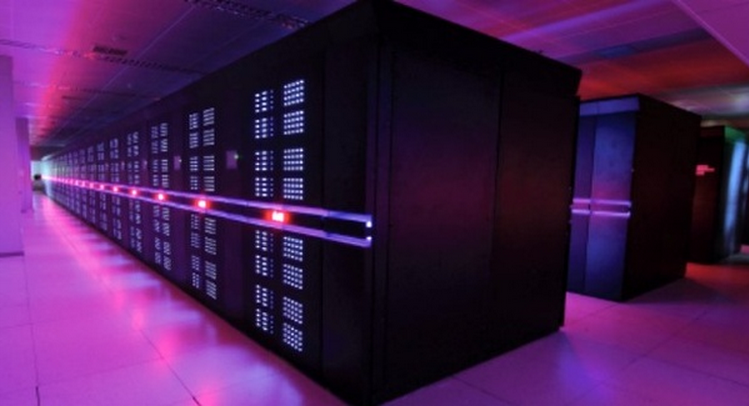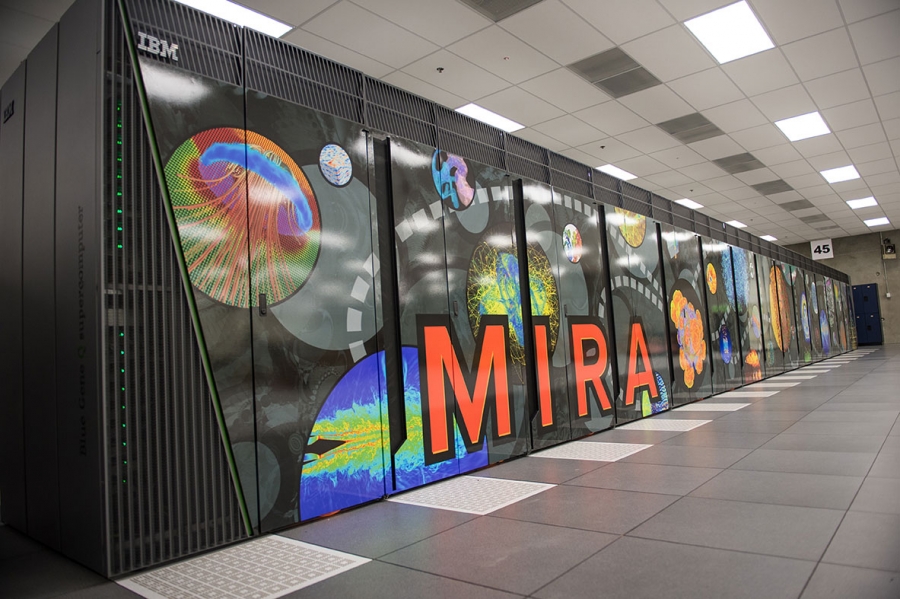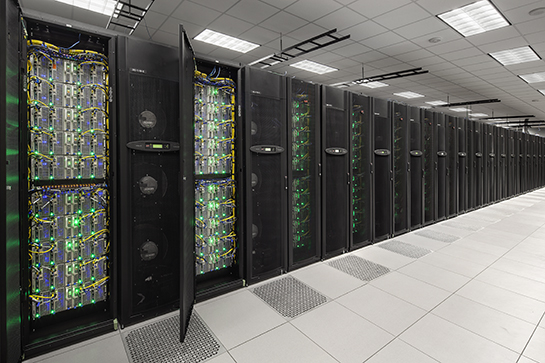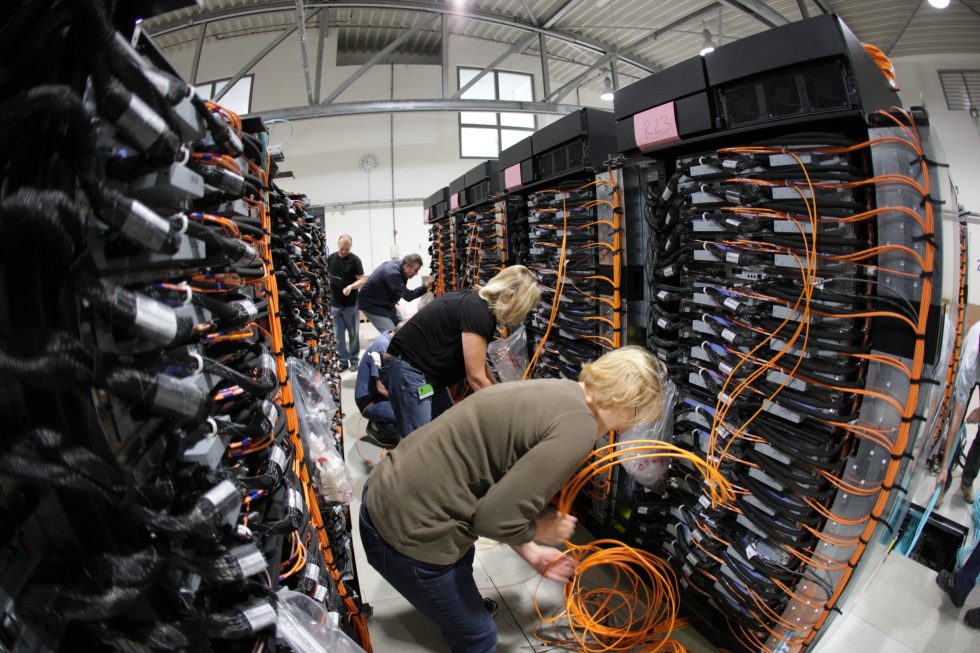Chinese supercomputer known as Tianhe-2 was today named the world's fastest machine, nearly doubling the previous speed record with its performance of 33.86 petaflops. Tianhe-2's ascendance was revealed in advance and was made official today with the release of the new Top 500 supercomputer list.
Tianhe-2 was developed at China's National University of Defense Technology and will be deployed in the country's National Supercomputing Center before the end of this year. "The surprise appearance of Tianhe-2, two years ahead of the expected deployment, marks China’s first return to the No. 1 position since November 2010, when Tianhe-1A was the top system," the Top 500 announcement states. "Tianhe-2 has 16,000 nodes, each with two Intel Xeon Ivy Bridge processors and three Xeon Phi processors for a combined total of 3,120,000 computing cores."
The combined performance of the 500 systems on the list is 223 petaflops, up from 162 petaflops in the previous list released six months ago. A petaflop represents one quadrillion floating point operations per second, or a million billion.
26 systems hit at least a petaflop. IBM's Blue Gene/Q accounted for four of the top 10, while Intel provided the processors for 80.4 percent of all Top 500 systems. 39 systems use Nvidia GPUs to speed up calculations, and another 15 use other accelerator or co-processor technology such as AMD's ATI Radeon and Intel's Xeon Phi.
252 of the 500 are installed in the US, 112 are in Europe, 66 are in China, and 30 are in Japan. The slowest computer on the list hit 96.6 teraflops, compared to 76.5 teraflops for the slowest computer on last November's list.
 |
#1: Tianhe-2, National University of Defense Technology in China
The followup to Tianhe-1A, the new world's #1 broke the speed record with performance of 33.86 petaflops. Tianhe-2 uses Ivy Bridge-based Intel Xeons and Intel Xeon Phi for a total of 3.12 million cores. The computer uses 17,808 kilowatts of power and can theoretically hit speeds of up to 54.9 petaflops.
|
 |
#2: Titan, Oak Ridge National Laboratory
Titan was #1 last November with a speed of 17.6 petaflops. The system uses AMD-based Cray CPUs and Nvidia GPUs in its 560,640 cores. Rated the third most energy efficient supercomputer last November, Titan uses 8,209 kilowatts of power.
|
 |
#3: Sequoia, Lawrence Livermore National Laboratory
The world's #1 supercomputer in June 2012, Sequoia is used by the National Nuclear Security Administration to conduct simulations aimed at extending the lifespan of nuclear weapons. The Blue Gene/Q system has nearly 1.6 million cores and hits speeds of 17.2 petaflops.
|
 |
#4: K computer, RIKEN Advanced Institute for Computational Science in Japan
Ranked #1 in the world in 2011, the K computer was made by Fujitsu. Delivering 10.5 petaflops with 705,024 Sparc cores, the K computer uses a six-dimensional torus interconnect called Tofu.
|
 |
#5: Mira, Department of Energy's Argonne National Laboratory
This Blue Gene/Q system uses 786,432 cores to hit 8.6 petaflops. When it hits full production in 2014 Mira will offer more than 5 billion computing hours per year to scientists (counting time on each core separately).
|
 |
#6: Stampede, Texas Advanced Computing Center at University of Texas
With Dell PowerEdge servers powered by Xeon processors and an InfiniBand interconnect, Stampede scored 5.2 petaflops. It is one of the largest systems in the world devoted to open science research—any researcher at a US institution can submit a request to use some of its computing power.
|
Besides Tianhe-2, the only new entrant in the top ten is a Blue Gene/Q system named Vulcan at Lawrence Livermore National Laboratory. Here is a look at the top ten:
 |
#8: Vulcan, Lawrence Livermore National Laboratory
This 4.3 petaflop system is based on IBM's Blue Gene/Q supercomputing technology and has 393,216 cores. This supercomputer isn't devoted solely to government use; Vulcan was recently opened to industry and research universities for collaborative projects.
|
 |
#7: Juqueen, Jülich Supercomputing Centre in Germany.
Another Blue Gene/Q system, Juqueen's 458,752 cores hit speeds of 5 petaflops. Using 2,301 kilowatts of power, Juqueen was rated the fifth most energy efficient Top 500 supercomputer last November.
|
 |
#9: SuperMUC, Leibniz Supercomputing Centre in Germany
Using IBM iDataPlex servers, 300TB of RAM, and an InfiniBand interconnect, SuperMUC's 147,456 cores achieved a speed of 2.9 petaflops. Energy costs are cut by directly cooling chips and memory with water at unusually high temperatures of 104 degrees fahrenheit.
|
 |
#10: Tianhe-1A, National Supercomputing Center in China
Ranked #1 in November 2010, Tianhe-1A uses Intel Xeon CPUs and Nvidia GPUs across its 183,368 processing cores for a rating of 2.6 petaflops.
|
No comments:
Post a Comment
Let us know your Thoughts and ideas!
Your comment will be deleted if you
Spam , Adv. Or use of bad language!
Try not to! And thank for visiting and for the comment
Keep visiting and spread and share our post !!
Sharing is a kind way of caring!! Thanks again!